West Durham's Faith Community
No fewer than nine congregations were organized in West Durham for
the workers at Erwin Mills. The Methodists started meeting in 1893 at
different cottages across the new mill village and eventually built
a frame church in 1896 at Ninth and Main (where the BP gas station now
stands). The Baptists set up shop on Ninth Street in 1894. Another Baptist group
established West Durham Baptist on Ferrell Street (near Swift Avenue
in Brookstown). Also in 1894, William Erwin (mill manager and devout Episcopalian)
started teaching Sunday school on the second floor of the company store
and post office on Ninth Street (later becoming St. Joseph's). The Prebyterians
organized in a small frame building on Bolton Street in 1905, near present-day
Erwin Square (later becoming Blacknall).
West Durham's Faith Community
In the beginning...
In 1911, the Pentecostal's began in a small mill house on Gin Street (behind the present-day Pizza Palace). In 1937, the West Durham Church of God was organized on Case Street in Brookstown (near present-day Duke School for Children).
Pilgrim Holiness Church held services in an old log cabin on Hale Street, near Hillsborough Road. The church burned down around 1980 (today a beauty salon occupies the site). After meeting in homes, brush arbors, tents, store buildings and halls, West Durham Wesleyan Church was built in 1915 at Ninth and West Knox (across from what is today the Magnolia Grill).
Grey Stone Baptist
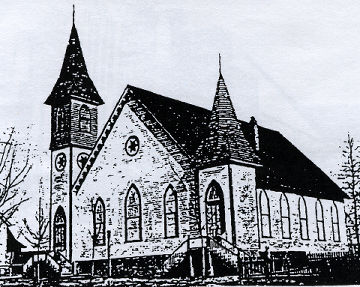
West Durham Baptist was organized in 1894 in a wood church building
on Ninth Street. A tornado destroyed the building in June of 1897 and
a second church (see drawing) was built on Alexander Avenue, near the
present-day Duke police station.
The taller tower housed the church bell which called folks in the community to service. During hot summer months the windows were raised and fans were furnished everyone.
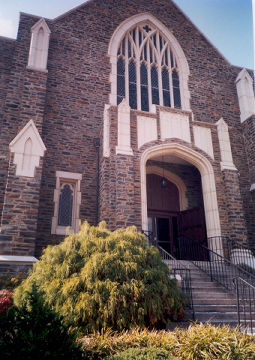 |
By 1933, the congregation had outgrown its building and a new church was constructed on Hillsborough Road, at 15th Street. The multi-colored granite was taken from the same Hillsborough quarry used to build Duke's West Campus. Conflict with another church with the same name prompted a new name, Grey Stone Baptist. They did get to keep the old church bell from Alexander Avenue. |
Source: Frances Edgerton
West Durham Baptist

Original West Durham Baptist Church. ca. 1890: Tintype of church shows some disrepair -- cardboard in windows, loose wood on roof. Church was located on Ferrell St. near Swift.
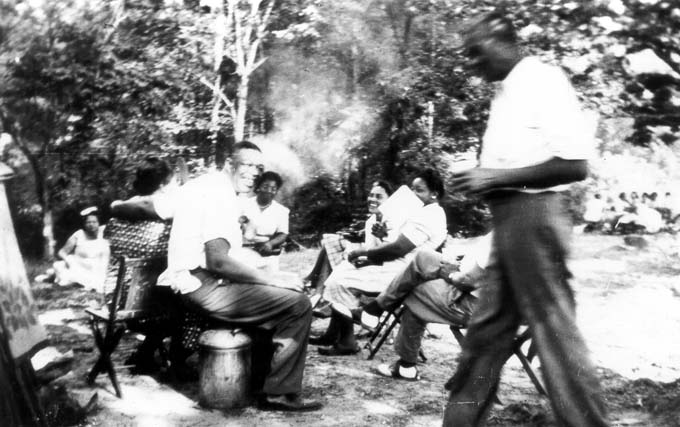
West Durham Baptist Church Barbecue. ca. 1940: Men and women of Sunday
School class enjoy barbecue in a backyard in Brookstown.
West Durham Pentecostal
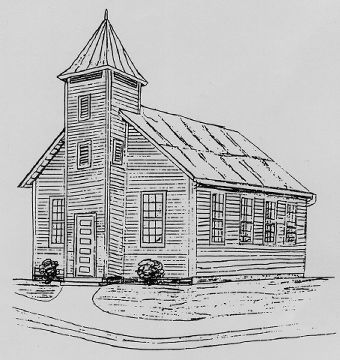 |
In 1911, the first Pentecostal Mission in West Durham began in a three room mill house of Mr. CE Cates on Gin Street (behind the present-day Pizza Palace). For nine turbulent years, services also took place at Mr. SW Avery's home on 15th Street, a hall on Ninth Street and Mr. AW Utley's home on 13th Street (present-day Bolton). |
In 1920, plans were
drawn for the Little While Church at Oakland and Alabama Avenue (see
pencil drawing above). With a tin roof and no ceiling, it was difficult
to heat the building so, people kept their benches near the stove to
keep warm.
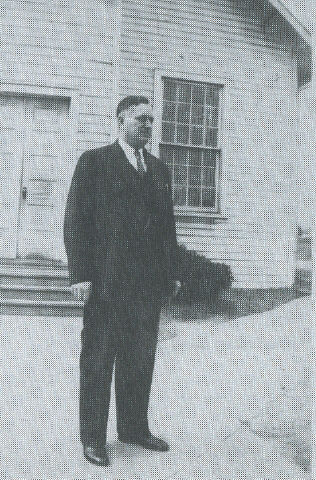 |
In 1941, Rev. D.D. Freeman started a popular Sunday morning radio show on WDNC. Rev. Freeman left to become a missionary in Africa but, the program remained on the air for 13 years and included the Porter Sisters Quartet and the church choir. |

Youth Group on Alabama Avenue. Rev. Kenneth Dantzler arrived in 1945
and soon after, construction began on the present-day church. By 1949,
services were being held in the basement of the new stone and brick
building.

West Durham Pentecostal overlooking Oakland Avenue, on the site of the
original Little White Church.
Source: Elaine Ashley, 1997
West Durham Church of God

The West Durham Church of God was organized in 1937 on Monkey Bottom's Case Street in a small plank church of rough-cut pine. From the beginning, it was difficult to build membership in a town dominated by Baptists and Methodists. The "new" West Durham Church of God was built in 1947 at the corner of Hillsborough and Knox. Above is a photo of the church on Easter Sunday in 1950. Today, an ABC store stands on the site.
Source: Janie Baker
West Durham Methodist
In 1893, Mr. Reuben Hibberd, a local florist and lay preacher, began holding cottage prayer meetings and "Sunday Sings" in mill houses around the Erwin Mill village. If the host family didn't have an organ, the Hibberd's would bring a small portable organ.
When the mill houses became too small to hold everyone, the Sunday School was moved to a grandstand in the baseball park on Broad Street (near present-day East Campus). It was during an 1894 revival in the grandstand that the West Durham Methodist Church was chartered.
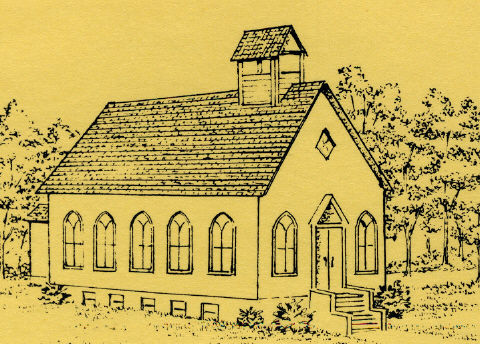
Two years later, Benjamin Duke deeded land at the corner of Ninth and West Main for a small chapel (where the BP gas station now stands).
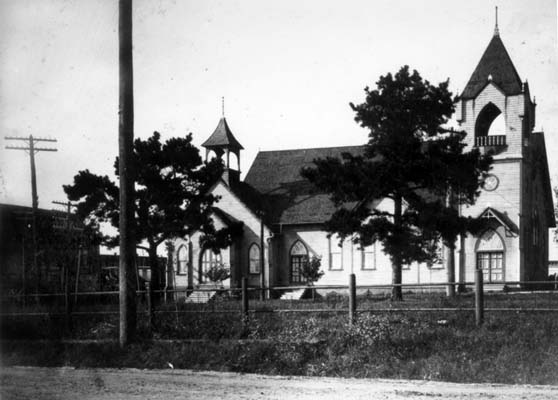
As membership grew, a larger church was attached to the chapel (original
chapel is far left). Photo taken in 1907.
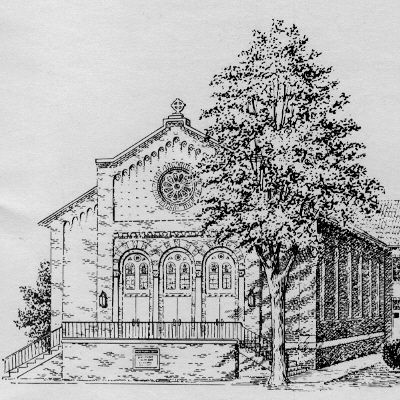
As membership grew to 600, Sunday School classes had to be separated
by green curtains. The congregation moved to its current location in
1927 and, as the church extended its reach beyond West Durham, changed
it name to Asbury Methodist in 1944.
Source: The Asbury Trail, courtesy of Pastor Ken Hall
Blacknall Presbyterian
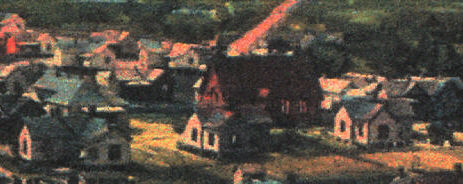
The Presbyterians
organized in a small frame building on Bolton Street in 1905 (near present-day
Erwin Square).
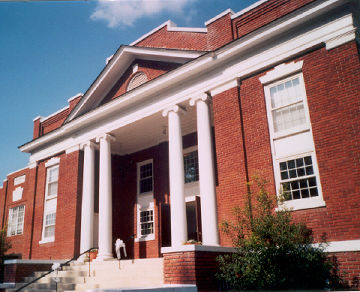
They moved to Blacknall Presbyterian on Perry Street in 1922.
Source: Architectural & Historic Inventory of Durham (Historic Preservation Society of Durham)
St. Joseph's Episcopalian
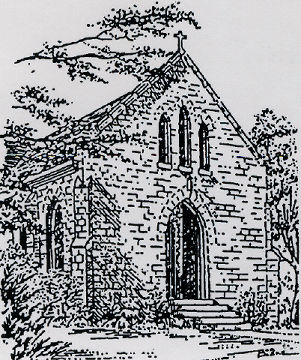
In 1894, William Erwin (mill manager and Episcopalian) started teaching
Sunday School on the second floor of the company store and post office
on Ninth Street.
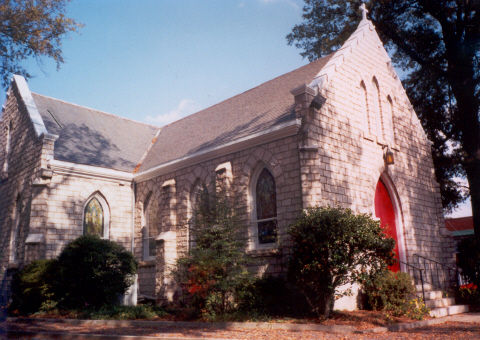
In 1908, the congregation moved one block east, to the corner of West
Main and Iredell. The cruciform cut-granite church, resembling an English
parish church, was named after Erwin's father. The Old West Durham Neighborhood
Association's monthly meetings take place in the church hall.
Source: Architectural & Historic Inventory of Durham (Historic Preservation Society of Durham)
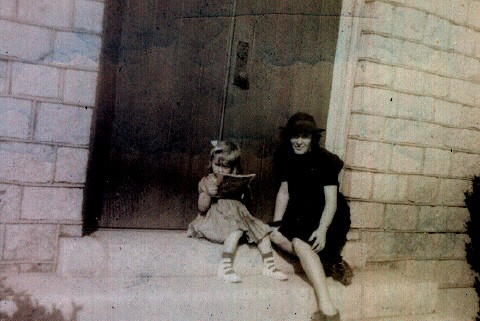
Nadine Stephens and mother, St. Joseph's church (ca. 1938)

Pilgrim Holiness Church
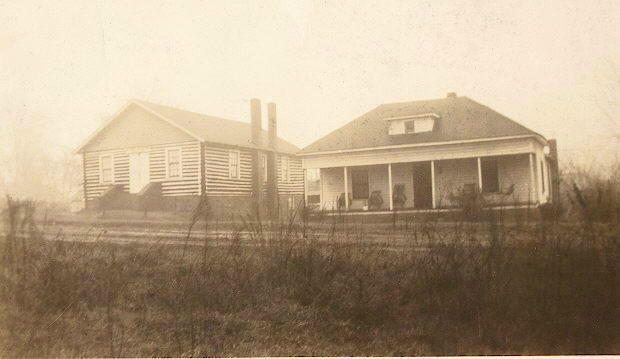
Around 1908, Rev. W.A. Way organized the Pilgrim Holiness Church at 2306 Gin Street (near Hale). The small white frame building had a steeple and stood next to a neighborhood fish market. In 1934, the congregation built a new log church at 805 Hale. The church was severely damaged by fire in 1978. Members then gathered at Howerton-Bryan funeral chapel and later First Wesleyan on Ninth Street. The new owners built the red brick beauty salon you see today below (some of the original logs are still in the walls). Brief History of Pilgrim Holiness.

West Durham Wesleyan Church
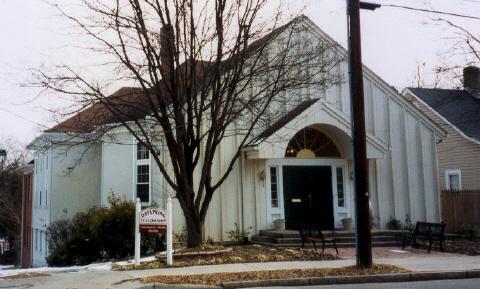
In the summer of 1907, a group of ministers and workers conducted a tent revival on Broad Street. Among the workers that day was Wesleyan minister Rev. Shuber Williams who followed up the meeting with services in different homes for the benefit of new converts to the Wesleyan faith. On January 10, 1908, thirty charter members organized the West Durham Wesleyan Church at the Hillsboro Road home of JE Conway (near Ninth Street).
The new church worshiped where it could; in homes, brush arbors, tents, store buildings and halls. In 1915, the congregation erected a small frame church and belfry at 922 Ninth Street (across from what is now the Magnolia Grill). In 1935, the sanctuary was lengthened 30 feet. Twenty years later, a two-story education wing was added in the back (towards Iredell).
In 1979, the church merged with another Wesleyan congregation, welcomed new members from the fire-damaged Pilgrim Holiness Church on Hale Street, and moved to a new location on Cole Mill Road. Today, the Dayspring Fellowship worships in the original church on Ninth Street.
| Night Gospel Meeting from West Durham Winter,
by And the prophet-preacher, boy with Bible and banjo, Once out, in the night air, they see the mills looming |
